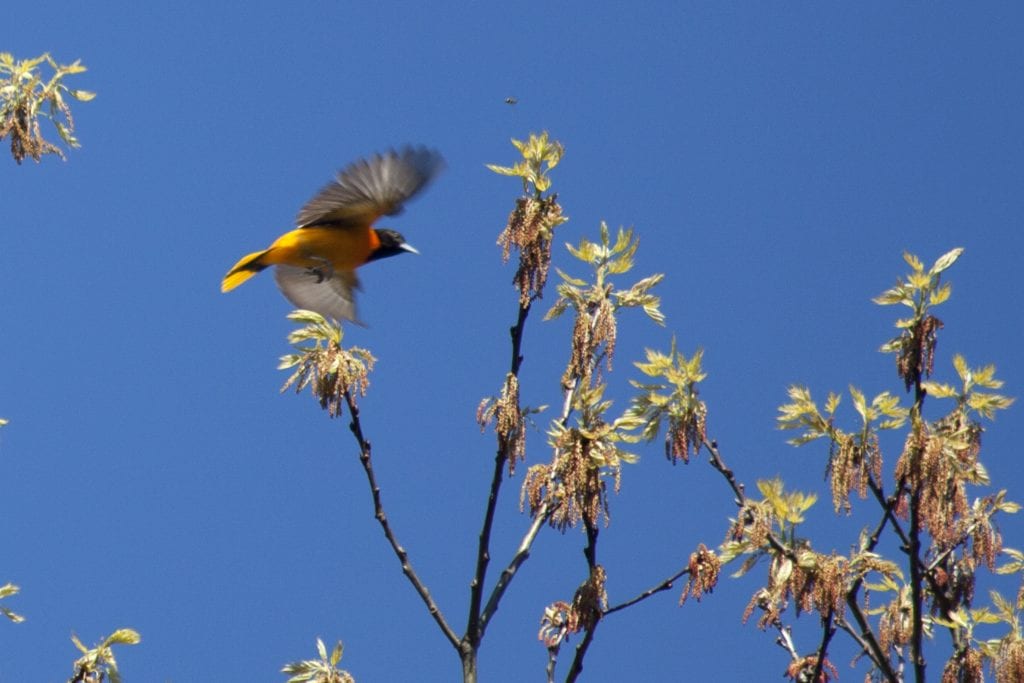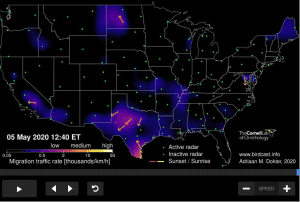
Nature in the Middle
The sights and sounds of birds around us are increasing every day as we move further into spring. This annual symphony of color and song is the result of something called migration. Migration is a strategy used by many bird species to survive seasonal changes in their environments. The birds that are now appearing across Maine’s landscape have traveled hundreds, and some even thousands, of miles from their winter locations.
Bird migration is a fascinating and astounding feat, and each year millions of birds will either come into or pass through Maine during their migratory journeys. Our “resident” migrants have come to Maine to feed, breed, and raise their young. Many of these birds are looking for insects, some for fish, and others for flowers and seeds. Maine’s natural landscapes provide a variety of important habitats and food sources for the survival of our seasonal avian residents.
 Since we typically only see individual or small groups of birds at any one time, it’s hard to appreciate how big an event bird migration is. BirdCast is a live online migration mapping tool that visually shows the bird migration traffic rate for the United States. Looking at these time-lapse maps gives you a visual perspective of how enormous these migratory movements are.
Since we typically only see individual or small groups of birds at any one time, it’s hard to appreciate how big an event bird migration is. BirdCast is a live online migration mapping tool that visually shows the bird migration traffic rate for the United States. Looking at these time-lapse maps gives you a visual perspective of how enormous these migratory movements are.
Scientists, naturalists, and bird-lovers have been recording data on bird migration patterns and timing for many decades. As we’ve learned in previous activities, phenology is the study of cyclic and seasonal natural events. In this week’s activity you’ll be collecting phenological data on spring bird migration.
ACTIVITY
1) Organize a datasheet to record consistent observations. Include:
a. Bird species name
b. Date
c. Time of observation
d. Where you saw it (feeder, ground, in a tree, etc.)
e. First record of the year? (yes or no)
2) Choose an observation post. This can be a home bird feeder, a group of trees in your yard, a local park or favorite trail you hike regularly.
3) Collect some background resources to help with bird identification and historical migration data for Maine. For bird identification, try Merlin. Also the Maine Birding Trail map includes a handy Maine bird checklist that you can use. For historical bird migration data you can do an internet search. eBird has a number of data sets related to bird migration.
4) Spring bird migration in Maine continues throughout the month of May and into early June. Keep your regular (daily or weekly) observations going throughout this period. Once complete, compare what you found with friends or classmates who may also be keeping track, as well as historical records you find during your research.
QUESTIONS TO CONSIDER
- Did you find any differences between your own data and what has been historically recorded?
- Has the historical data remained consistent over time, or have changes been recorded?
- If changes have occurred, how might those changes be a reflection of other phenological changes (in climate, plants, etc.)?
This is an activity that you can do each spring. Nature is dynamic, and changes in one area are often reflected in others. Having prior data will help you make predictions about what you might expect to see at any particular time during spring migration.
Migration is not without its hazards and unfortunately many birds will not survive their journeys. Storms, habitat destruction, starvation, navigation disrupted by artificial light pollution, and collision with buildings are a few of the challenges that birds must face. With so many birds moving at this time of year, spring is an excellent time for people to do what they can to help out our feathered friends.
Saturday, May 9, is World Migratory Bird Day. In honor of this day, here are some things you can do to help our migrating birds during their journey:
- Turn off unneeded artificial light sources around your home at night.
- Plant native trees, shrubs and flowers around your home (here are some suggestions from Maine Audubon).
- Keep family cats indoors.
- Help prevent bird window collisions at your home; check out the allaboutbirds website for ideas.
- Fuel a hungry hummingbird. For instructions on how to make a simple homemade hummingbird feeder watch this short video.
Until next week, keep an eye on the sky!
NOTE FOR TEACHERS
If you’re doing this activity with your students have them give weekly updates of their data along with any problems or questions they’ve encountered. Try giving a weekly reflection question that will serve as a formative assessment for you as you guide them to go deeper into what the data may or may not be suggesting. This activity addresses the following NGSS standards: LS2-1&2, ESS3-5
Our educators, scientists, advocates, and naturalists are committed to keeping you connected to the natural world as we deal with the coronavirus situation together. Check in every weekday on our Connections page for family activities, parent/teacher tips, backyard birding, nature exploration at our sanctuaries, and more.
